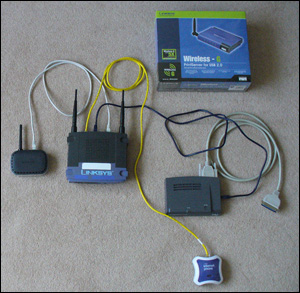 If you have anything more than a single computer in your home, you need to think about how you are going to wire things. Less than ten years ago, creating your own network at home meant running cables everywhere, even if it meant buying 50 yards of cat-5 Ethernet cable or putting holes in your walls!
If you have anything more than a single computer in your home, you need to think about how you are going to wire things. Less than ten years ago, creating your own network at home meant running cables everywhere, even if it meant buying 50 yards of cat-5 Ethernet cable or putting holes in your walls!
Thankfully, we now have the option of trading all of that cable for a wireless network. However, before you invest, make sure that you know what kind of system might work best for you!
Wired Systems
At the most basic level, a wired system hooks your computer up to the Internet by running a cable from your computer to the device in your home that produces your connection. If you pull out the cable, your computer no longer connects to the Internet. This is the older version of the home network, but it is far from outdated!
For example, hooking your computer physically to the connection point is more stable than using a wireless connection, and it also involves the use of less equipment; you do not have to buy a router if the only device you are hooking up to the connection is your computer.
However, if you want other devices hooked up to your system, you will need a router that can unite the various devices. Even if there is more than one computer in the area, there is a good chance that you will want things like a printer hooked up as well. This can make quite a tangle if you are not careful. Alternately, you can use one computer as your server and hook other machines up to it.
Wireless Systems
A wireless system hooks a wireless router up to the connection point in your home, and then the router broadcasts a signal that can be picked up by the machines in the area. This frees you from the need to have cables everywhere, and there is no practical limit for how many machines can access the internet.
You are not limited by the number of ports and you can have your network spread out throughout your home. Most types of office equipment now have a wireless connection, so you can connect your entire home office very quickly.
There are issues to consider before you invest in a wireless network, however. First, remember that it needs to be secured. You do not want just anyone getting on your network, after all. Learning to secure your network so that only the machines that you know can access it takes a bit of time. Also remember that the signal strength can vary, depending on where you place it in your home.
Making a Decision
Both wired and wireless networking systems are relatively easy to set up. Most computers connect instantly to a wired connection, and all wireless routers now carry a step-by-step process that helps you connect the entire home. Both systems absolutely have their advantages and disadvantages, so the choice should be made based on your home network’s needs.
When you want to network your home computers, you have plenty of choices in front of you. Whether you choose a classic plug-and-play wired connection or you choose a wireless router, always consider your own situation and what your needs may be!
About the author: Bobby Marks is an IT geek and blogger for several technology blogs. For more information on wireless technology, click here.
Credits: Photo courtesy of Clive Darr.